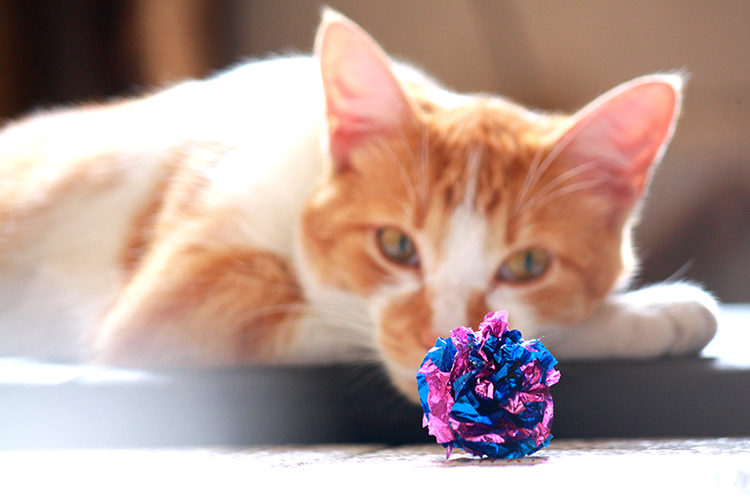Cat toys are to homes with cats what Legos are to homes with kids: easy to step on in the middle of the night, though usually with less painful results. You probably have dozens of cat toys scattered across your home right now. Your cat might even play with 25% of them, though let’s face it – they’re probably more interested in the box they came in.
For those toys they play with, when’s the last time you checked how clean they are? …Are you blinking in confusion at the screen? No time like the present then! Read our guide on how to maintain and clean your cat’s toys, and then carry out your own inspection.
Regularly Inspect Your Cat Toys
Make regular visual inspection of all cat toys a regular part of your day. When you’re collecting their toys at bedtime, or bringing them out first thing in the morning, check for any damage. If the toy is less frequently used, like a fishing line toy that’s only used a couple times a week, just check it every time that you use it.
Is a toy leaking its stuffing? Has a plastic toy gotten scratched up? Is fake fur clumping together from SO MUCH LICKING? Has anything been peed on?
If you answered YES to any of the questions above, you may need to clean or throw out that toy.
When to Throw Your Cat’s Toys Away
When the toy has had its guts ripped out and is leaking stuffing, go ahead and toss that toy. (Toy funeral optional.) Do the same with any toy that has loose parts – like an eye hanging loose or a partially ripped away tail (unless you can safely and completely remove the dangling part). Material used for stuffing or small pieces could be ingested by your cat, leading to a traumatic time for everyone at the vet’s. Avoid the potential bowel obstruction and lean on the safe side: throw the toy away!
Along the same lines, if you have any plastic toys that have developed scratches on their surfaces, it’s a good idea to discard those as well. The small grooves can provide space for bacteria to hang out – if your cat runs around with the toy in their mouth, they could get sick.
Lure toys with broken feathers should also be discarded; try to find toys that let you swap out the lure when they need to be replaced.
If the toy is just too grimy and disgusting, having been dragged through every dust bunny hiding in your home – or gotten peed on or dropped in the litter box – just throw it out.
There are a few key ways you can clean your cat’s toys, but do this first: check the manufacturer’s guidelines for cleaning the toy in question. Not sure how to find them? Try Googling the name of the toy plus the phrase “cleaning guidelines,” “cleaning instructions,” or “care instructions.”
Spot Clean
Most toys that feature feathers or are faux fur should be treated delicately and spot cleaned. When you’re cleaning feathers, you can simply rinse them thoroughly with hot water and hang them to dry. For faux fur, scrub gently at any soiled spots with a little mild dish soap and then rinse it off well without allowing the toy to be soaked with water.
Hand Wash
Plastic or rubber toys should be hand washed. Don’t stick them in your dishwasher, as it may cause them to break. Instead, use hot water and a mild dish soap; make sure to scrub them gently with a cloth, sponge, or soft brush to avoid scratching the surface of the plastic toys. Alternatively to dish soap, you may be able to clean them by soaking them in a mixture of water and white vinegar.
For fabric toys, you can hand wash them in hot water with some mild dish soap mixed in. Soap them up, scrub gently at any stains, then rinse thoroughly and let them air dry completely.
Machine Wash
Some toys may stand up to machine washing. Check the manufacturer’s cleaning instructions before you throw them in the washing machine to avoid good toys wearing out before their time.
It’s generally advisable to wash these fabric toys in hot water with a mild detergent that contains no dyes or fragrances. (Strong fragrances could make your cat avoid the toy, and you don’t want your cats putting anything in their mouths that might have toxic residue.) Do an extra rinse, as well, then let the toys air dry.
A Special Note on Catnip Toys
Catnip toys are just so TASTY to cats, and so they tend to get extra loved on with plenty of licking and chewing thrown in for good measure. These toys should be brought out only under your supervision, and given extra care.
If you can, get the kind of catnip toy that is refillable. They’re the easiest to keep clean since you can simply remove the old catnip, wash the toy, and then refill once it’s clean. This minimizes the chance of mold growing on the herb inside a toy that’s often soaked with cat saliva.
These cleaning methods are super easy and doable, so get yourself on a regular routine of properly caring for your cat’s toys – it’s a much easier daily chore than litter box maintenance! And your cat will actually thank you for it with some play time, too.








